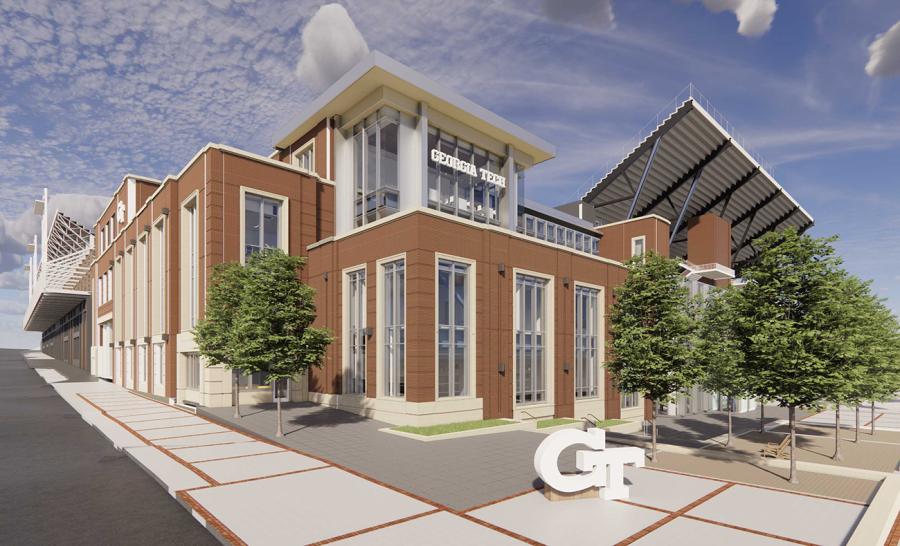Rendering courtesy of The S/L/A/M Collaborative
Located in the northeast corner of Bobby Dodd Stadium at Hyundai Field, the Fanning Center will serve as a hub for Georgia Tech student-athletes, with areas dedicated to strength and conditioning, sports medicine (including mental health services) and nutrition, as well as expanded and enhanced meeting and office space exclusive to Georgia Tech football.
An expansion project in Atlanta designed to modernize Georgia Tech's historic football stadium and potentially help recruiting is officially under construction.
Georgia Tech officials broke ground March 25 on the Thomas A. Fanning Student-Athlete Performance Center, a project designed by The S/L/A/M Collaborative (SLAM) and constructed by DPR Construction, both of which are Atlanta-based companies.
The Fanning Center was approved by the Board of Regents of the University System of Georgia in April 2022.
The building is named for Tech alum Thomas A. Fanning, a booster who holds three degrees from the university and was considered a visionary in the energy industry during a 43-year career with Southern Company, the Georgia-based utility.
Fanning attended the groundbreaking ceremony alongside Georgia Tech President Ángel Cabrera, J Batt, the university's director of athletics, and Brent Key, Tech's head football coach.
The 100,000-sq.-ft. expansion is taking place at the northeast corner of the century-old stadium — now called Bobby Dodd Stadium at Hyundai Field — in hopes of boosting the prestigious school's football program and other athletic teams.
Urbanize Atlanta reported that the facility is rising within the footprint of the former Edge/Rice Center, Tech's former concrete-built athletics headquarters, and will utilize a modified, more traditional design than what was initially envisioned three years ago.
The performance center will house areas for athlete strength and conditioning, sports medicine, nutrition, academic support and Georgia Tech athletics' Total Person Program.
In addition, it will include expanded space specifically for the football program, such as a players' lounge, meeting spaces and strength-and-conditioning facilities. School officials believe that the new building will boost its athlete recruiting efforts.
The Fanning Center will be the site of Georgia Tech's first sports science lab, according to Urbanize Atlanta, which will use pro-model motion tracking to analyze student-athletes' performance data that will feed into an in-house data analytics office for performance tracking and analysis.
According to SLAM representatives, the Fanning Center's building process will use energy-reduction strategies. Steel from Bobby Dodd Stadium's existing infrastructure is planned to be woven into the expansion project, where cross-laminated timber will also be used throughout to add warmth and reduce the project's carbon footprint.
Its construction is expected to coincide with normal operations at the historic stadium, which originally opened as a smaller facility in 1913. It has since been upgraded and expanded several times.
"As the college athletics landscape evolves, we're thrilled to start bringing Georgia Tech's vision for student-athletes and its campus to life," explained Brian Oliver, DPR Construction's project executive, a Georgia Tech graduate, and member of the Yellow Jackets' men's basketball squad that advanced to the university's first NCAA Final Four in 1990. "We're also proud that this project will help support opportunities for local workers in the skilled trades, many of whom feel personal connections with the campus and its athletic program."
Plans call for the Fanning Center to open for student-athletes in the spring of 2026.
Cheshire Bridge Repairs Not Likely to Finish Until Late May
The city of Atlanta is still working to complete repairs on the Cheshire Bridge Road span after a December fire shuttered the roadway, causing a headache for residents who rely on the overpass to commute, the Atlanta Journal-Constitution reported April 1.
Atlantans waiting patiently for construction to wrap up received the unfortunate news during the last week of March when the Atlanta Department of Transportation (ATLDOT) projected the completion date to be the end of May.
Atlanta City Council member Alex Wan, who represents that area of the city, wrote in his regular newsletter that the ATLDOT noted May 14 is the target date to reopen the roadway, with May 27 the anticipated final day of construction.
"This is not the news I had hoped to be able to give to you today, but as I have, I'll continue keeping you informed as frequently as I can throughout this entire project," Wan wrote. "The administration knows my/our frustration with the pace (or lack thereof) with the repair."
Early project timelines from the department targeted the reopening the bridge in 10 weeks, which would have meant the roadway would have been ready for use by early spring.
A recent project update document from the ATLDOT noted that progress has been delayed by "property access negotiations, site preparation, required document approvals and inclement weather."
"We understand the urgency in restoring this road for the community and stakeholders," according to the transportation department. "Our goal is to complete construction quickly, with safety as the highest priority."
Luckily, the damage did not require the entire bridge to be rebuilt, the Journal-Constitution reported, but repairs included demolishing and replacing the damaged portion of the structure, shoring up existing utility and supports, and constructing a retaining wall and new roadway to connect the remaining portion of the bridge to the road.
Today's top stories











